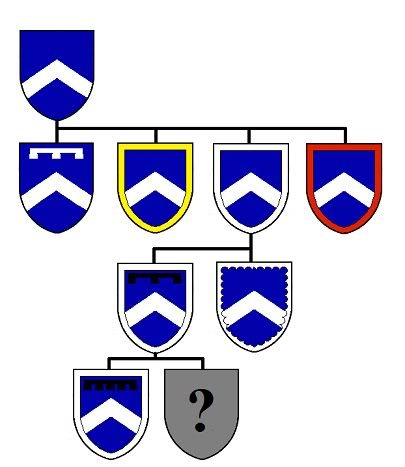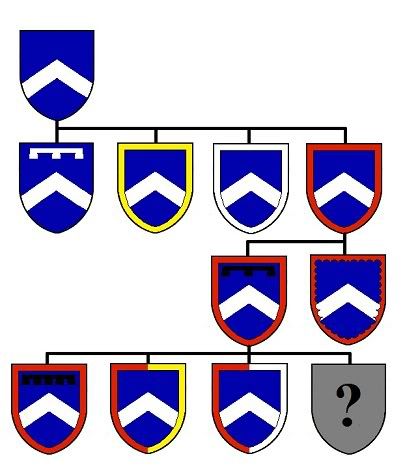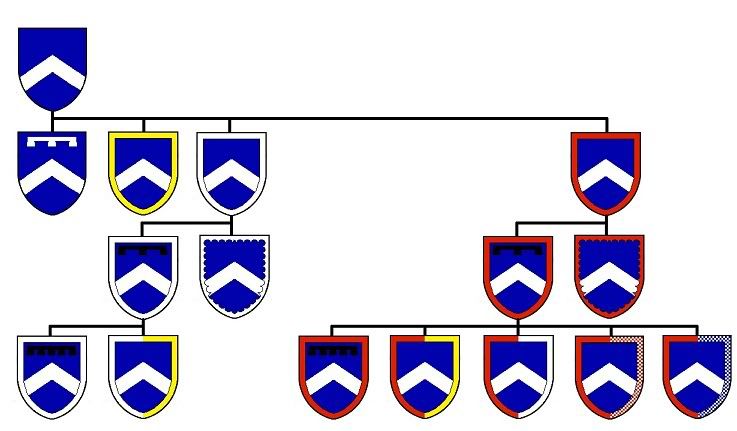|
-
2nd September 10, 08:52 AM
#1
Two Question on Differencing
I've had a couple of questions about how to difference arms when the usual conventions cause problems or would be unclear. I've prepared two examples:
1.

In this case (and correct me if I'm wrong) the Stodart system would divide the bordure per pale with a colour denoting the son's birth order. However, this leads to the breaking of the "no metals on metals" rule (as the dexter side would be Argent and the sinister side would be Or). How would one deal with this?
2.

In the second case, the "question shield" would (and again, correct me if I'm wrong) have the bordure split as above. In this instance, both sides of the border would be Gules so the bearer's arms would be identical to those of his father and eldest brother. Would the sinister half be chequy Gules and Argent? Or is there another way to show the bearer's place within the family?
I apologize if some or all of my assumptions are off-base; I admit to having limited resources on the subject.
Thank you, once again, for tolerating all of my questions!
-
-
2nd September 10, 09:43 AM
#2
 Originally Posted by Cygnus

I've had a couple of questions about how to difference arms when the usual conventions cause problems or would be unclear. I've prepared two examples:
1.

In this case (and correct me if I'm wrong) the Stodart system would divide the bordure per pale with a colour denoting the son's birth order. However, this leads to the breaking of the "no metals on metals" rule (as the dexter side would be Argent and the sinister side would be Or). How would one deal with this?
In this instance the metals are beside one another and the convention of not placing metal on metal (or colour on colour) is not contravened. This side-by side placement occurs frequently when arms are divided party per cross (that is quartered) or less frequently when divided per fess or per pale.
 Originally Posted by Cygnus

2.

In the second case, the "question shield" would (and again, correct me if I'm wrong) have the bordure split as above. In this instance, both sides of the border would be Gules so the bearer's arms would be identical to those of his father and eldest brother. Would the sinister half be chequy Gules and Argent? Or is there another way to show the bearer's place within the family?
I apologize if some or all of my assumptions are off-base; I admit to having limited resources on the subject.
Thank you, once again, for tolerating all of my questions!
Bordures are used as the cadets come off the stem, and not in any particular particular generation (see Gayre, Heraldic Cadency pg. 140). When a situation arises that a bordure might be indistinguishable from the field (argent with a bordure argent) the bordure is represented as chequey (as in the arms of Innes of Edingight-- argent three mullets azure within a bordure chequey argent and azure).
Now, generally speaking, in the instance of your "?" shield the bordure would be per pale, gules (red) and chequey argent (white) and azure (blue), the argent and azure being derived from the principle metal and colour of the arms.
I hope that answers your question!
Scott
-
-
2nd September 10, 10:19 AM
#3
 Originally Posted by MacMillan of Rathdown

In this instance the metals are beside one another and the convention of not placing metal on metal (or colour on colour) is not contravened. This side-by side placement occurs frequently when arms are divided party per cross (that is quartered) or less frequently when divided per fess or per pale.
Bordures are used as the cadets come off the stem, and not in any particular particular generation (see Gayre, Heraldic Cadency pg. 140). When a situation arises that a bordure might be indistinguishable from the field (argent with a bordure argent) the bordure is represented as chequey (as in the arms of Innes of Edingight-- argent three mullets azure within a bordure chequey argent and azure).
Now, generally speaking, in the instance of your "?" shield the bordure would be per pale, gules (red) and chequey argent (white) and azure (blue), the argent and azure being derived from the principle metal and colour of the arms.
I hope that answers your question!
Scott
That does indeed. And thank you for clearing up how the bordures are used - I had assumed it was to mark specific generations.
Now, to muddy the waters a bit. Assuming these cadets are springing up in perfect order, what if another son was added to the final generation?
It seems the next colour to be used for a bordure is azure, but it has already been used by the elder brother. Does this mean that, when the parent arms have a bordure, that particular colour is skipped when impaling the bordures for any cadet matriculations?
Here's another tree to show what I'm asking:

And I've put Heraldic Cadency on my Amazon.com wishlist just in case one comes up for sale. A quick search shows it's a difficult book to come by!
Thank you, Scott, for your patience and explanations.
-
-
2nd September 10, 12:18 PM
#4
Next!
 Originally Posted by Cygnus

That does indeed. And thank you for clearing up how the bordures are used - I had assumed it was to mark specific generations.
QUESTION 1 Now, to muddy the waters a bit. Assuming these cadets are springing up in perfect order, what if another son was added to the final generation?
QUESTION 2 It seems the next colour to be used for a bordure is azure, but it has already been used by the elder brother. Does this mean that, when the parent arms have a bordure, that particular colour is skipped when impaling the bordures for any cadet matriculations?
Here's another tree to show what I'm asking:

And I've put Heraldic Cadency on my Amazon.com wishlist just in case one comes up for sale. A quick search shows it's a difficult book to come by!
Thank you, Scott, for your patience and explanations.
RE: QUESTON 1 The next colour in precedence would be sable (black), so in all likelihood the bordure would be per pale gules and sable.
RE: QUESTION 2 Mr. Stoddart is the man credited with devising the "scientific" system of cadency by bordure. Following his system one gets (theoretically at least) to the 14th son of the 14th son of the original grantee before there is any possibly of duplication. His table of precedence for bordures reads as follows:
COLOURS: Or, Argent, Gules, Azure, Sable, Vert, Purpure,Tenne, Ermine, Contre-ermine, Erminoise, Pean, Vair, Potent (phew!)
Variation of Lines of Partition: Engrailed, Invected, Indented, Embattled, Wavy, Nebuly, Rayonee, Raguly, Nowy, Countre-nowy, Dovetailed, Potenty, Urdy, Round-embattled. (phew! again!)
And to reiterate what Gayre has said, the above order is used as the cadets come off the stem, and not in any particular generation.
Knowing all this stuff is why Heralds get the big bucks...
So, looking at the above chart, the fifth son of the original grantee would have a full bordure chequy argent and azure (because we can't have a blue field with a blue bordure). Two generations down, his fourth grandson would have a bordure per pale chequy argent and azure, and gules (the reverse of his cousin's bordure which is per pale gules and chequy argent and azure). So, placing the two similar arms side by side we can tell at a glance that both gentleman have a common great-grandfather, and that one descends from the fourth son, while the other descends from the fifth son of that illustrious gentleman. We can also see that each is the fourth son of their respective fathers.
Pretty neat, huh?
With regard to "skipping over" colours in bordures, the only time this happens is when chequy is substituted for the colour to clearly show the bordure against the field (background colour) of the arms. As each generation tumbles down, the bordure may be further varied by impaling, quartering, or gyronny, in addition to varying the lines of partition.
Last edited by MacMillan of Rathdown; 2nd September 10 at 02:25 PM.
-
-
2nd September 10, 12:56 PM
#5
WOW! That's all I can say gentleman. WOW!
[I][B]Ad fontes[/B][/I]
-
-
2nd September 10, 01:04 PM
#6
Thank you, once again, for this most useful information! I have stored it away on my computer for future reference.
 Originally Posted by MacMillan of Rathdown

RE: QUESTON 1 The next colour in precedence would be sable (black), so in all likelihood the bordure would be per pale gules and sable.
Looking at the chart, though, did I not skip the colour Gules in the lowest row of sons (i.e., wouldn't the fourth son have a bordure "gules | gules"? If so, how does one show that?)
 Originally Posted by MacMillan of Rathdown

Knowing all this stuff is why Heralds get the big bucks...
Maybe I should invest more time in learning it... 
 Originally Posted by MacMillan of Rathdown

Pretty neat, huh?
It most certainly is! I've been interested in heraldry ever since I was a small boy wishing that there was more variation in my Lego figures' shields!
-
-
2nd September 10, 02:12 PM
#7
 Originally Posted by Cygnus

Looking at the chart, though, did I not skip the colour Gules in the lowest row of sons (i.e., wouldn't the fourth son have a bordure "gules | gules"? If so, how does one show that?)
Probably the easiest solution would be to devise a bordure per pale gules, chequy argent and gules, especially given that the next in line will have per pale gules chequy of argent and azure. Sorry I overlooked this in your original question.
(The way this generally works is to take the colour and add the first named metal to create the chequy. If the bordure is a metal, then the first named colour is added to create the chequy.)
Last edited by MacMillan of Rathdown; 2nd September 10 at 02:29 PM.
-
-
2nd September 10, 02:26 PM
#8
 Originally Posted by Cygnus

And I've put Heraldic Cadency on my Amazon.com wishlist just in case one comes up for sale. A quick search shows it's a difficult book to come by!
Here some used copies for sale, if that helps:
http://www.abebooks.com/servlet/Sear...ency&x=59&y=14
"Touch not the cat bot a glove."
-
-
2nd September 10, 02:37 PM
#9
Thank you, MacMan! That is very helpful!
Scott, no problems at all - I was just wondering. Thank you for the clarification.
In case anybody else has been following, this is the "final" chart (please correct me if it's wrong):

Thanks again!
-
-
2nd September 10, 02:58 PM
#10
Looks good to me.
(And the Gayre books are well worth the asking price.)
-
Similar Threads
-
By budd4766 in forum Contemporary Kilt Wear
Replies: 15
Last Post: 16th February 09, 06:25 AM
 Posting Permissions
Posting Permissions
- You may not post new threads
- You may not post replies
- You may not post attachments
- You may not edit your posts
-
Forum Rules
|
|






















Bookmarks